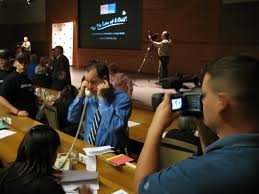Call centers can sometimes try our patience, especially when we are in a hurry, anxious for an answer to a problem, and all we get is a recorded voice telling us to press a number depending on our requirements, only to find we then have to push another number, and then another…
However, customer service cannot be packaged to simply sit on a shelf at our beck and call whenever we need it; everybody has to “get in line” with help from technical support, banks, credit card companies and stores.
Understanding caller patience is vital
For people who work in call centers, understanding caller patience is vital.
Professoors Che-Lin Su and Baris Ata from the University of Chicago Booth School of Business carried out a study which was published in the journal Management Science.
They say they offer a more accurate approach to modelling caller patience, which should reduce customer waiting time and will help businesses.
Su, a professor of operations management said:
“Knowing when a person decides to hang up or hang on is vital to streamlining call center operations, minimizing caller frustration and maximizing each customer service encounter.”
Call centers can design better systems, or improve the ones already in use if they can predict caller behavior.
Understanding how callers behave and what triggers specific reactions is especially important when firms plan changes in their business, or launch a major marketing campaign that produces a surge in inquiries.
Bad call centers can undermine advertising campaigns
Ata, also a professor of operations management, said:
“It’s no use spending millions on advertising a new product, service or event if your call center can’t cope with the customer response.”
An efficient and seamless call center that works rapidly makes everybody happier, including customers who stay calmer, phone agents who become less agitated, and business gets done more efficiently.
The authors add that these insights may also help businesses negotiate smarter contracts for outsourcing these services.
Ata explains:
“Since the model produces more realistic results for how long a caller will stay on the line, it enables a more precise estimate for the number of callers who can be served per hour, day and month.”
The authors gathered and analyzed caller behavior data from 1.3 million calls made to an Israeli bank’s customer service center.
They tested their new model to determine whether previous research assumptions that caller patience never changes held true, even if the center improved call priority and routing systems.
Su explained:
“The previous models used assumptions of caller abandonment that were easy to apply and analyze, but didn’t provide a reasonable picture of people’s patience.”
Caller patience is often overestimated
They ran four scenarios that simulated changes in call priority on both models, and found that the older-style assumptions were probably misleading, because they produce caller-abandonment predictions that were highly inaccurate.
In many cases, assumptions had overestimated how long a caller is willing to stay on the line waiting, or underestimated how much it would take for a caller to hang up.
Su concluded:
“When a call center alters its discipline to improve speed and service, add agents, or change call routing and priority, we theorized those things should influence caller patience – and our model shows that such improvements do indeed make a difference in whether people decide to hang up or hang on.”

